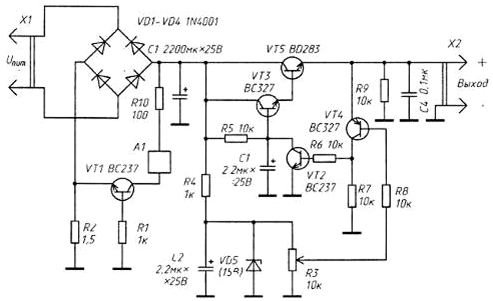Audible alarm allows the user to quickly respond to emergency if experimenting with various electronic equipment have any overloading of the power source. The circuit of the power source with audible alarm of exceeding current consumption shown in the figure.

The rectifier diodes VD1-VD4 eats from the transformer, the secondary winding of which is designed for a voltage of 18 V At the load current of at least 1 A.
Adjustable voltage regulator transistors VT2...on VT5 well-known scheme. Variable resistor R3 on the output of the regulator can be set to a voltage from 0 to +15 V.
The detector, indicated on the diagram of the device A1 is a generator of sound frequency connected to an acoustic radiator (dynamic sound head, the piezoelectric acoustic transducer, etc.). It a schematic diagram is provided as a designer can choose more acceptable sound (tonal frequency, siren, multi-tone trill, the melody, the simulator different sounds).
On the diagram of the device are only managing the operation key on the transistor VT1.
Load current (EUT) passes through the resistor R2, creating on the voltage drop. While the current is small (at the selected value of this resistor is not more than 0.3 (A), the transistor VT1 is closed.
The increase in the current consumption (and thus increase the voltage on the resistor) transistor approaches the threshold of the opening. When the voltage between base and emitter transistor VT1 reaches 0.7, opens it, and with a further increase in current will enter the state the saturation.
When opening transistor rectified voltage is supplied to the acoustic detector, and leads him into action.
In the described power source you can use domestic element base. The transistors. VS interchangeable on KT639B; S - CTB and BD283 - KT815A.
Instead part no 1n4001 diodes suitable rectifier diodes CDB or diode bridge CCE. As a Zener diode you should use XA. The power dissipation of the resistor R2 is taken with some margin from the calculation of the increased current consumption, for example 1 watt.
Author: Galoyan A.






